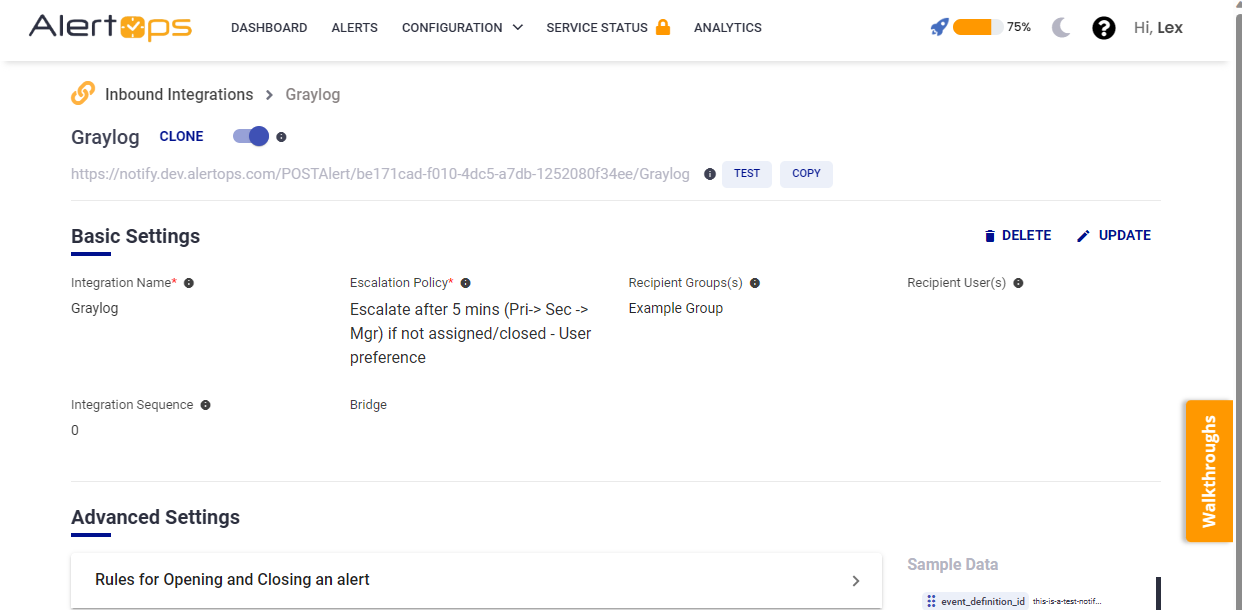- 11 May 2023
- 4 Minutes to read
- Print
- DarkLight
- PDF
Graylog
- Updated on 11 May 2023
- 4 Minutes to read
- Print
- DarkLight
- PDF
AlertOps and Graylog
The Graylog software centrally captures, stores, and enables real-time search and log analysis against terabytes of machine data from any component in the IT infrastructure and applications. The software uses a three-tier architecture and scalable storage based on Elasticsearch and MongoDB
AlertOps’ alert management system can be integrated with Graylog to receive and respond to all (predefined status mappings) alerts through email, SMS, push notification or phone alerts. AlertOps would ensure that the alert/job status would reach the appropriate team by using proper workflows, escalation policies and schedules. Based on your ruleset, incidents can be automatically opened and closed, depending on the event Graylog reports.
The above scenario and scope for integration is due to the fact that AlertOps has a very flexible and simple API/Webhook configuration feature that can be leveraged with Graylog's event creation and notification capabilities.
AlertOps - Inbound Integration
We can define rulesets in AlertOps so that Graylog can send out event alerts to the AlertOps platform. AlertOps would ensure based on these notifications received, that it would always reach out and assign to the correct person/team by utilizing its escalation policies, schedules, and workflow features.
AlertOps provides Inbound Integrations to integrate with numerous monitoring, chat and ITSM tools. You can configure an inbound integration for Graylog.
At a high level this is how the flow looks like, you define an API integration in the AlertOps platform by defining settings like Integration Name, Escalation rules, recipient users/groups. Once an integration is defined, a unique API URL is generated. This acts as webhook or the gateway through which notifications from Graylog reach AlertOps and thus an incident/alert is created correspondingly. The API can be defined with various settings like URL mappings, filters, escalations etc. as required. Graylog has to be configured with event definitions and webhook notifications.

Configure Inbound Integration in AlertOps
- Navigate to Configuration àIntegrations àAdd API Integration à API Integration Detail page.
- Select Graylog
- Once you select the integration, you can then specify basic settings like the integration name, escalation policy, names of the recipients/groups for which the alerts must be assigned to.
- Once you click save, the API Integration will be created, and you will be given a unique URL which acts as the access point and needs to be configured at the source (in this case Graylog), to send alerts. You can find the integration you just created, and you can give advanced settings and define various configurations for the alerts to be received and processed. For example, you can define when to open and close alerts based on the payload obtained from the API call, filters etc.

- Make a note of the API URL, which will be used in Graylog, so it calls a HTTP POST request to this URL with the body in JSON format containing the alert specific information. AlertOps automatically creates an alert when the status variable (priority) contains '3/4'. The incident will also be closed automatically when the status '1/2' is received from Graylog.
- The above mapping to open and close alerts depends on what value each priority denotes. You will have to verify this in Graylog/Graylog Docs.

- You can similarly define URL mappings as you want, owing to the flexibility provided by AlertOps’ OpenAPI/Plug-and-Play integrations. You can provide other filters and match with regex expressions as well. You can also test the generated URL with the sample data provided.
Configure Integration in Graylog
- Alerts are created using Event Definitions that consist of Conditions. When a given condition is met it will be stored as an Event and can be used to trigger a notification
- To set alerts, notifications and event definitions, click on 'Alerts' in the top navigation pane
- You can get started by defining Event definition for the alert
- Make sure you set event definitions for both above and below threshold conditions. Make sure you give the priority values accordingly. (for mapping in AlertOps)
- Notifications can be created by selecting the Notifications button under the Alerts tab, or by defining them in the Event workflow.
- In the 'Notifications' section, give a title, description, give the 'Notification Type' as HTTP Notification
- Paste the AlertOps Inbound Integration API URL in the URL field.
- You can test the Webhook. Create.

Thats it! You have configured a Webhook Notification for events. Any alert would now be sent to AlertOps for incident management.
Message logs, alert specific information can be viewed in the “Inbound Log” section in AlertOps Dashboard. Alerts can be viewed in the ‘Alerts’ tab as well.
Alert Triggering Information
AlertOps will automatically create an incident when a new alert is received from Graylog when the priority field contains "3/4".
If an alert with status "3/4" matches an existing Open Alert, AlertOps will recognize the new alert as a duplicate and ignore the alert.
The alert will be recorded in the Inbound Messages table as “Mapped Appended.”
AlertOps will automatically close the same incident when an alert with error^status contains '1/2'.


